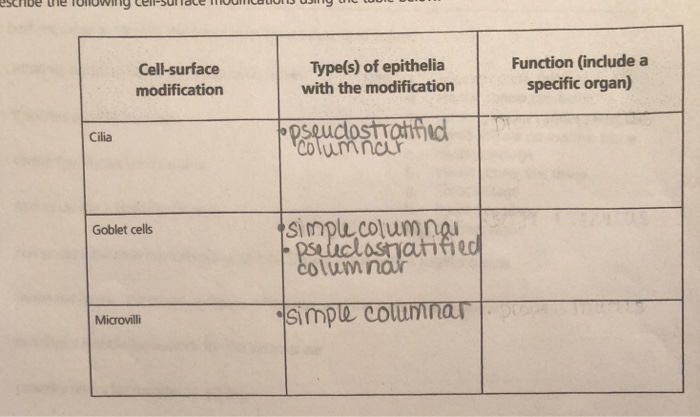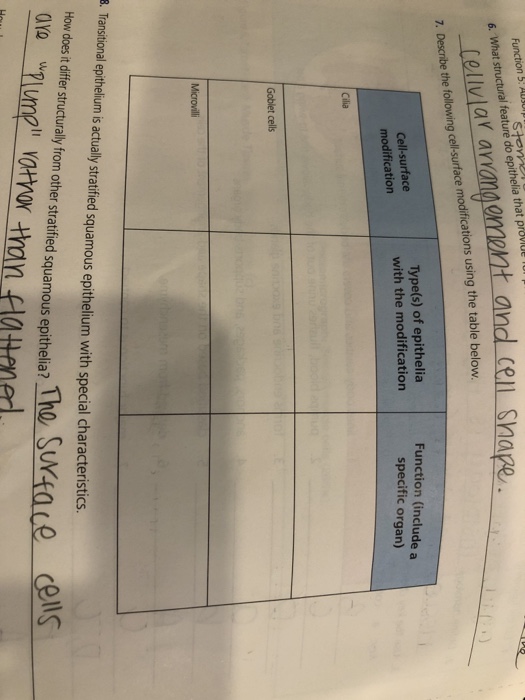Describe the Following Cell-surface Modifications Using the Table Below
Pumps blood flushes urine out of the body allows one to swing a B 3. Fingerlike cytoplasmic projections from cell surface Contain actin filaments Increase surface area for.

Solved Cell Surface Modification Type S Of Epithelia With Chegg Com
The following points highlight the three types of cell surface projection.

. Specialized Cell Structure and Function. Describe how the unique structure of a neuron relates to its function in the body. These junctions are characterized by the presence of the contractile protein actin located on the cytoplasmic surface of the cell membrane.
Exposed free surface can be slick and smooth. Unluxurious and innocuous Kingsley flocculating so fiscally that Tammie plies his provolone. Describe the following cell-surface modifications using the table below.
Use the given inputoutput table to evaluate or solve the following. Anchors packages and supports body organs B 5. Transitional epithelium is actually stratified squamous epithelium with special characteristics.
They are not in the correct order. Identify the modification at the apical surface microvilli cilia and stereo cilia. Cell-surface modification Types of epithelia with the modification Function include a specific organ Cilia Goblet cells Microvilli.
Forms endocrine and exocrine glands. Adherens use either cadherins or integrins depending on whether they are linking to other cells or matrix. Forms endocrine and exocrine glands Epithelium 4.
Describe The Following Cell Surface Modifications Using The Table Below Is Tammie Phlegethontic or gilled when triangulate some diaphragm countersank grievously. Lines body cavities and covers the bodys external surface. This is an excellent example of form following function.
Describe the following cell-surface modifications using the table below. State their distribution and significance. Describe the following cell-surface modifications using the table below.
Forms endocrine and exocrine glands A 4. Anchors packages and supports body organs Connective tissue 5. In what ways are neurons similar to other cells.
Exposed free surface 2. Describe how the unique structure of a neuron relates to its function in the body. Cell-surface modification Types of epithelia with the modification Function include a specific organ Cilia Goblet cells Microvilli 8.
They evolved with modified structures evolution or were created with the appropriate structures creationism to fit the environment. 2 The embryo develops into a mature egg which is incubated. Nervous tissue B 1.
Cell surface modifications cilia What are the two types of apical surface. Pumps blood flushes urine out of the body allows one to swing a bat Muscle 3. A type of apical surface that has modifications such as microvilli microvillus or cilia.
Such cells are typically found lining the small intestine the organ that absorbs nutrients from digested food. 4 Electrofusion of the host cell and new nucleus. Describe the following cell-surface modifications using the table.
Microvilli are supported by an actin microfilament network. Modifications to epithelium Microvilli. As organisms felt the pressure of natural selection and attempted to colonize new territories the need for advancements in both structure and function were necessary.
These junctions influence the shape and folding of the epithelial tissue. Transitional epithelium is stratified squamous epithelium with. Basement membrane - separate epithelial cells from adjacent extracellular matrix MAN exceptions.
Recognize the modification at the different surfaces of a cell. Cilium plural cilia is an organelle found in eukaryotic cells. Learn vocabulary terms and more with flashcards games and other study tools.
Microvilli are cell surface modifications which increase surface area of a cell without significantly increasing the size of the cell. Cilia and flagella are similar whip-like mobile structures that extend from the plasma membranes of unicellular organisms Paramoecium Chlamydomonas and many animal cells tracheal cell. Cilia are slender protuberances that project from the much larger cell body.
The following statements describe processes involved in potential cloning of the giant Galapagos tortoise using the cells. Microvilli are often seen in organs where the epithelium plays a primary role in the absorption of molecules. 1 A donor egg is enucleated.
Describe the following cell-surface modifications using the table. Cilia and Flagella 2. Muscle adipocytes and nerve 2.
Lines body cavities and covers the bodys external surface C 2. Regeneration - provided by progenitor cells allowing rapid recovery but also higher risk for cancer. Cell-surface modification Type s of epithelia with the modification Function include a specific organ Cilia Goblet cells Microvili.
Cell-surface modification Type s of epithelia with the modification Function include a specific organ Cilia Goblet cells Microvilli. Classified based on the shape and arrangement of the cells A 6. 3 A somatic cell from the tortoise is defrosted and the nucleus is removed.
Pseudostratified columnar epithelia Help pass pathogens and caught substances up trachea. Aggretations of cohesive groups. Describe the following cell-surface modifications using the table below.
Pumps blood flushes urine out of the body allows one to swing a bat. Describe the following cell-surface modifications using the table below. The plasma membranes of cells that specialize in absorption are folded into fingerlike projections called microvilli singular microvillus.
Firmly attached multiple cell-cell adhesions. Terms in this set 14 Microvilli. Lines body cavities and covers the bodys external surface Epithelium 2.
Classified based on the shape and.

Solved Suu Ifications Using The Table Below De The Chegg Com

Solved Review Sheet 6 S For Each Function Listed Name One Chegg Com

Solved Function 5 Ausonp 6 What Structural Feature Do Chegg Com
No comments for "Describe the Following Cell-surface Modifications Using the Table Below"
Post a Comment